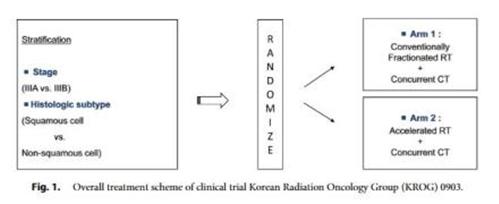글로벌 연구동향
방사선종양학
- 2023년 04월호
[Int J Radiat Oncol Biol Phys .] Randomized, Multicenter, Phase 3 Study of Accelerated Fraction Radiation Therapy With Concomitant Boost to the Gross Tumor Volume Compared With Conventional Fractionation in Concurrent Chemoradiation in Patients With Unresectable Stage III Non-Small Cell Lung Cancer: The Korean Radiation Oncology Group 09-03 Trial
3기 비소세포성 폐암의 동시항암화학방사선치료에서 가속분할동시추가 방사선치료와 통상분할 방사선치료의 무작위배정 다기관 3상 연구 (KROG 09-03)전남의대 / 김용협, 안성자*,
- 출처
- Int J Radiat Oncol Biol Phys .
- 등재일
- 2023 Mar 15
- 저널이슈번호
- 115(4):873-885.
- 내용
Abstract
Purpose: We designed the Korean Radiation Oncology Group 09-03 phase III clinical trial to compare accelerated hypofractionated radiation therapy (RT) using a concomitant boost to the gross tumor volume (GTV) with conventionally fractionated 60-Gy RT in patients with stage III unresectable non-small cell lung cancer (NSCLC).Methods and materials: A conventionally fractionated RT group (arm 1; 124 patients) received a 2-Gy daily dose to a total cumulative dose of 44 Gy to the planning target volume (PTV) in 22 fractions and 60 Gy to the GTV in 30 fractions over 6 weeks. A hypofractionated RT group (arm 2; 142 patients) received a 1.8-Gy daily dose to the PTV with a synchronous boost of 0.6 Gy to the GTV, for total cumulative doses of 45 Gy to the PTV and 60 Gy to the GTV in 25 fractions over 5 weeks. All patients received concurrent weekly chemotherapy consisting of paclitaxel and cisplatin.
Results: The objective response rate of all patients was 86.5% (arm 1, 84.6%; arm 2, 88.1%; P = .612). The median overall survival was 26 months (arm 1, 26 months; arm 2, 27 months; P = .508). The median progression-free survival was 11 months (arm 1, 10 months; arm 2, 13 months; P = .295). The local tumor control rates at 2 and 5 years were 58.3% and 50.7%, respectively (arm 1, 62.4% and 51.0%, respectively; arm 2, 54.0% and 48.6%, respectively; P = .615). There were no significant between-group differences in the cumulative incidence of grade ≥3 radiation pneumonitis (P = .134) or radiation esophagitis (P = .539).
Conclusions: This clinical trial did not confirm the superiority of accelerated 2.4-Gy hypofractionated RT compared with conventional 2-Gy fractionation in patients with unresectable stage III NSCLC undergoing concurrent chemoradiation therapy.

Affiliations
Yong-Hyub Kim 1, Sung-Ja Ahn 2, Sung Ho Moon 3, Jin Hee Kim 4, Young-Chul Kim 5, In-Jae Oh 5, Cheol Kyu Park 5, Jae-Uk Jeong 1, Mee Sun Yoon 1, Ju-Young Song 1, Chang-Ok Suh 6, Kwan Ho Cho 4, Sun Hyo Park 7
1Department of Radiatio Oncology, Lung and Esophageal Cancer Clinic, Chonnam National University Medical School and Hwasun Hospital, Hwasun, Republic of Korea.
2Department of Radiatio Oncology, Lung and Esophageal Cancer Clinic, Chonnam National University Medical School and Hwasun Hospital, Hwasun, Republic of Korea. Electronic address: ahnsja@chonnam.ac.kr.
3Proton Therapy Center, Research Institute and Hospital, National Cancer Center, Goyang-si, Republic of Korea.
4Department of Radiation Oncology, Keimyung University Dongsan Medical Center, Daegu, Republic of Korea.
5Department of Internal Medicine, Lung and Esophageal Cancer Clinic, Chonnam National University Medical School and Hwasun Hospital, Hwasun, Republic of Korea.
6Department of Radiation Oncology, Bundang CHA Medical Center, CHA University, Seongnam-si, Republic of Korea.
7Keimyung University School of Medicine, Division of Pulmonology, Respiratory Center, Keimyung University Dongsan Hospital, Daegu, Republic of Korea.
- 덧글달기







